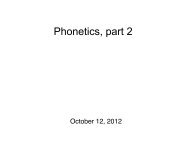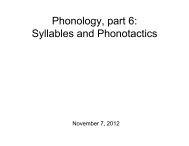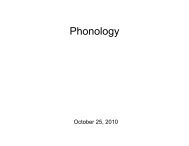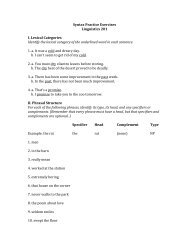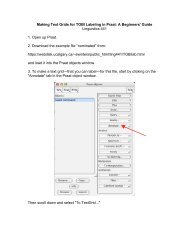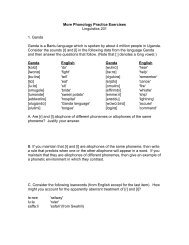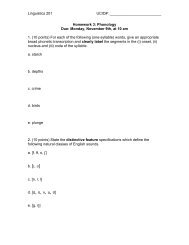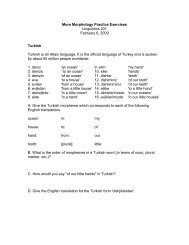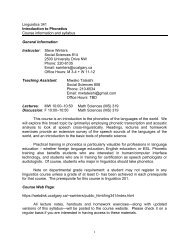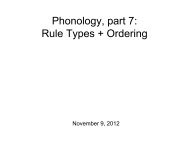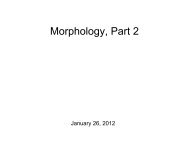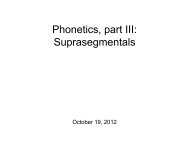Transcription Exercise - Basesproduced.com
Transcription Exercise - Basesproduced.com
Transcription Exercise - Basesproduced.com
Create successful ePaper yourself
Turn your PDF publications into a flip-book with our unique Google optimized e-Paper software.
<strong>Transcription</strong> <strong>Exercise</strong>: Vowels<br />
Linguistics 341<br />
for in-class discussion on Friday, March 21st, 2014<br />
I. Turkish<br />
Turkish is an Altaic language which is spoken by about 50 million people, primarily in<br />
Turkey, where it is the official language.<br />
Things to watch out for in Turkish: front rounded vowels, [y] and [ø], and back<br />
unrounded vowel [ɯ].<br />
Examples<br />
(Note that the final [ɹ] and [l] are devoiced in these examples.)<br />
1. [k h iɹ] ʻdirtʼ<br />
2. [k h yɹ] ʻhealth cureʼ<br />
3. [k h ɯɹ] ʻcountryʼ<br />
4. [k h ɔɹ] ʻred hot cinderʼ<br />
5. [k h uɹ] ʻFrench courseʼ<br />
6. [k h il] ʻFullerʼs earthʼ<br />
7. [k h ɯl] ʻhairʼ<br />
8. [k h ɔl] ʻarmʼ<br />
9. [k h ɛl] ʻringwormʼ<br />
10. [ø:lɛ] ʻnoonʼ
<strong>Exercise</strong>s<br />
1.<br />
2.<br />
3.<br />
4.<br />
5.<br />
6. ʻeastʼ<br />
7. ʻknotʼ<br />
8. ʻendeavorʼ<br />
9. ʻfamilyʼ<br />
10. ʻthingʼ<br />
11. ʻvillageʼ
II. British English<br />
Things to watch out for in this variety of British English: the low, back, rounded vowel<br />
[ɒ], and long reversed epsilon [ɜ:].<br />
Examples<br />
1. [bḁd̥h ] ʻbadʼ<br />
2. [k h ɜ:ɫ] ʻcurlʼ<br />
3. [mɒk h ] ʻmockʼ<br />
4. [flɔ:] ʻflawʼ<br />
5. [t h aɪ] ʻtieʼ<br />
6. [b̥ɔ:d̥h ] ʻboardʼ<br />
7. [dɑ:k h ] ʻdarkʼ<br />
8. [hʌt h ] ʻhutʼ<br />
9. [g̥ɜ:ɫ] ʻgirlʼ
<strong>Exercise</strong>s<br />
1. ʻbaredʼ<br />
2. ʻcullʼ<br />
3. ʻmarkʼ<br />
4. ʻfloorʼ<br />
5. ʻtireʼ<br />
6. ʻbodeʼ<br />
7. ʻdotʼ<br />
8. ʻhurtʼ<br />
9. ʻgullʼ
III. Accents of English: New Zealand English<br />
The following passage <strong>com</strong>es from a speaker of New Zealand English. Listen to<br />
the utterance, and then identify the segments which she produces differently than<br />
the way you would normally produce them in your variety of English. Then<br />
provide a list of transcriptions (for just those segments) which are appropriate for<br />
both your pronunciation and the speakerʼs pronunciation.<br />
Sample utterance:<br />
“There is, according to legend, a boiling pot of gold at one end. People look, but no one<br />
ever finds it.”



